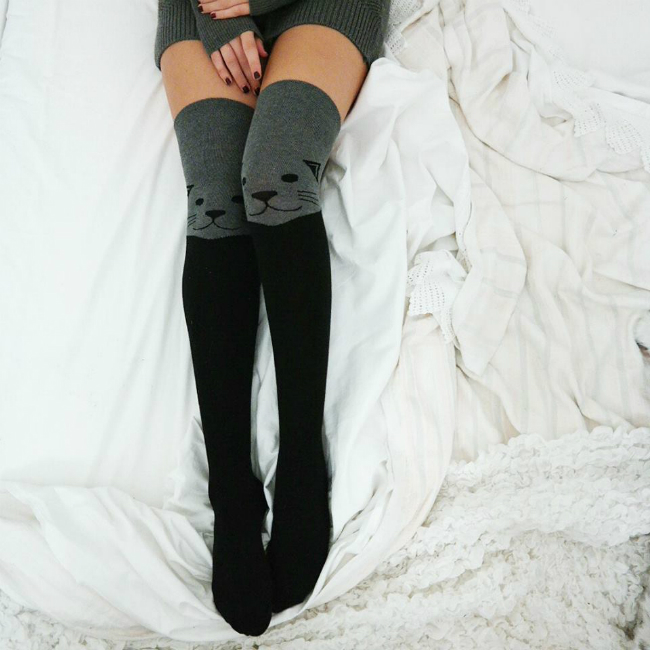Sleeping with Socks On: The Science and Myths
Do you ever find yourself slipping into bed with a cozy pair of socks on? Some people swear by the comfort and warmth it provides, while others shy away from the idea of sleeping with socks on. In this article, we'll dive into the science behind sleeping with socks on and debunk some myths associated with this bedtime practice.
Understanding the Basics of Body Temperature Regulation
Before we get into the world of socks and sleep, let's first understand how our bodies regulate temperature. Our internal thermostat, located in the brain, works tirelessly to maintain a stable body temperature. Throughout the day, our body temperature fluctuates slightly, typically peaking in the afternoon and dropping during the night.
But have you ever wondered why our body temperature changes throughout the day? Well, it turns out that our body's temperature regulation is influenced by various factors such as our circadian rhythm, physical activity, and even the environment we are in. Our circadian rhythm, also known as our internal body clock, plays a significant role in determining when our body temperature is at its highest and lowest points. This natural rhythm is responsible for our sleep-wake cycle and helps regulate many physiological processes, including body temperature.
Now, let's take a closer look at how our feet come into play in this delicate temperature balance.
The Role of Feet in Body Heat Distribution
Your feet play a crucial role in maintaining our body's temperature equilibrium. Being the farthest body parts from your core, they tend to lose heat faster. This is because the blood vessels in our extremities, including our feet, constrict in response to cold temperatures, reducing blood flow and heat transfer to these areas. As a result, our feet can feel cold, especially during colder seasons or when exposed to chilly environments.
Interestingly, the sensation of cold feet can have a significant impact on our sleep quality. When our feet are cold, it can be harder for some individuals to fall asleep or stay asleep throughout the night. This discomfort can disrupt the natural sleep cycle and lead to restless nights.
How Sleep is Affected by Body Temperature
Research suggests that a lower core body temperature can promote better sleep. When we sleep, our body temperature drops naturally, signaling our internal clock that it's time for rest. This drop in temperature helps us feel drowsy and facilitates the transition into a deep, restorative sleep.
During the night, our body goes through different sleep stages, each with its unique characteristics and functions. As we enter deep sleep, our body temperature continues to decrease, reaching its lowest point in the early hours of the morning. This decrease in body temperature is believed to enhance the quality of our sleep, allowing our body to repair and rejuvenate itself.
However, external factors such as room temperature and bedding can also influence our body's ability to regulate temperature during sleep. If the room is too warm, it can hinder the natural drop in body temperature, making it harder to fall asleep or stay asleep. On the other hand, a cool room temperature can promote a more comfortable sleep environment, facilitating the body's natural temperature regulation process.
Understanding how our bodies regulate temperature and the role of our feet in this process can help us create an optimal sleep environment. By keeping our feet warm and maintaining a cool room temperature, we can support our body's natural temperature fluctuations during sleep, promoting better sleep quality and overall well-being.
The Science Behind Sleeping with Socks On

Now that we have a better understanding of body temperature regulation, let's explore the impact of sleeping with socks on.
But first, let's go deeper into the fascinating world of body temperature regulation. Our bodies are designed to maintain a stable core temperature, which is crucial for optimal functioning. Throughout the day, our body temperature fluctuates, with the highest point usually occurring in the late afternoon and the lowest point during the early morning hours. This natural drop in body temperature is a signal to our bodies that it's time to rest and rejuvenate.
During sleep, our body temperature continues to decrease, reaching its lowest point in the early hours of the morning. This drop in temperature is essential for quality sleep, as it allows our bodies to enter a state of deep sleep, where restorative processes occur.
The Impact on Sleep Quality
Contrary to popular belief, wearing socks to bed may actually improve sleep quality for some individuals. By keeping your feet warm and toasty, socks help prevent the loss of body heat through your extremities, creating a cozy environment conducive to rest and relaxation. This can be particularly beneficial for those who struggle with cold feet or have poor circulation.
When our feet are cold, our blood vessels constrict, reducing blood flow to the extremities. This constriction can make it harder for our bodies to reach that optimal state of deep sleep. However, by wearing socks to bed, we can help keep our feet warm, allowing our blood vessels to remain dilated and promoting better blood flow throughout the body.
Additionally, wearing socks can also help regulate body temperature during sleep. As our body temperature drops, our feet are often the first to feel the chill. By providing an extra layer of insulation, socks can help maintain a comfortable temperature for our feet, preventing any discomfort that may disrupt sleep.
Potential Health Benefits
Believe it or not, wearing socks to bed might offer more than just a comfortable night's sleep. Research suggests that warm feet can aid in the dilation of blood vessels, promoting better blood flow throughout the body. This increased circulation has been associated with various health benefits, including improved sleep, reduced inflammation, and enhanced healing.
Improved blood flow can help deliver essential nutrients and oxygen to our cells more efficiently, supporting overall health and well-being. It can also help remove waste products and toxins from our tissues, contributing to a healthier body.
Furthermore, the dilation of blood vessels can have a positive impact on our immune system. By enhancing blood flow, our immune cells can travel more effectively throughout the body, helping to fight off infections and illnesses.
So, the next time you slip on a pair of cozy socks before bed, remember that you're not only ensuring a warm and comfortable night's sleep but also potentially reaping the benefits of improved blood circulation and overall health.
Debunking Myths About Sleeping with Socks On
Now, let's debunk some common misconceptions surrounding the practice of sleeping with socks on.
Addressing Common Misconceptions
One prevalent myth is that wearing socks to bed can make your feet sweat excessively. While it's true that socks can trap moisture, this is typically not an issue if you choose breathable materials like cotton or moisture-wicking fabrics. These materials help regulate foot perspiration and minimize discomfort.
But did you know that wearing socks to bed can actually have some surprising benefits? For starters, it can help improve circulation. When you sleep, your body temperature drops slightly, and this can cause your blood vessels to constrict. By wearing socks, you can keep your feet warm and prevent this constriction, allowing for better blood flow throughout your body.
Furthermore, sleeping with socks on can also help you fall asleep faster. Research has shown that warming your feet before bed can signal to your brain that it's time to sleep. So, if you struggle with insomnia or have difficulty falling asleep, slipping on a pair of cozy socks might just do the trick.
Separating Fact from Fiction
Another myth suggests that wearing socks to bed can negatively affect your feet's ability to breathe and lead to fungal infections. However, proper hygiene and choosing clean socks can mitigate these risks. Simply make sure to wash your feet before bed and opt for socks made of breathable materials, allowing your feet to breathe comfortably throughout the night.
Moreover, wearing socks to bed can actually help prevent dry and cracked heels. During the colder months, the skin on our feet tends to become dry and rough. By keeping your feet covered with socks, you create a barrier that locks in moisture and prevents your heels from becoming dry and cracked. So, not only will your feet feel cozy, but they'll also look and feel healthier.
Additionally, sleeping with socks on can be particularly beneficial for people with Raynaud's disease. This condition causes the blood vessels in the extremities, such as the fingers and toes, to constrict excessively in response to cold temperatures or stress. By wearing socks to bed, individuals with Raynaud's can keep their feet warm and reduce the frequency and severity of symptoms.
In conclusion, sleeping with socks on is not just a matter of personal preference, but it also has some surprising advantages. From improving circulation and promoting better sleep to preventing dry heels and aiding those with certain medical conditions, wearing socks to bed can be a simple yet effective way to enhance your overall sleep experience. So, don't let the myths deter you, give it a try and see how it benefits you!
Potential Drawbacks and Risks
While sleeping with socks on can bring various benefits, it's essential to consider potential drawbacks and associated risks.
One potential drawback of sleeping with socks on is the concern for circulation. While socks can help improve circulation for many individuals, those with circulation issues or chronic conditions like diabetes should consult their healthcare provider before adopting this habit. It is important to ensure foot health and safety, as certain medical conditions may warrant caution.
Another aspect to consider is the impact on skin and foot health. Proper hygiene and care are crucial for maintaining foot health. Socks that are not changed regularly or made of non-breathable materials can increase the risk of fungal infections and other skin-related issues. It is important to choose socks made of breathable materials and change them regularly to prevent such problems.
Individuals with sensitive skin should also be mindful of potential irritations that socks can cause. Some materials or tight-fitting socks may cause discomfort or skin irritations, so it is important to choose socks that are gentle on the skin and provide a comfortable fit.
Tips for Sleeping with Socks On
For those considering joining the socks-in-bed club, here are some tips to help you make the most out of this practice.
Choosing the Right Socks for Sleep
Select socks that are comfortable, breathable, and suitable for sleeping. Look for natural materials like cotton or synthetics, as they are known for their breathability and moisture-wicking properties. Avoid socks with thick seams or constricting bands that can cause discomfort during the night.
Alternatives to Improve Sleep Quality
If the idea of sleeping with socks on doesn't resonate with you, there are alternative ways to enhance sleep quality. Consider investing in a warm, cozy blanket to keep your overall body temperature regulated or try using a heating pad for focused warmth on your feet.
Sleeping with socks on can be a personal preference that offers both comfort and potential health benefits. By understanding the science behind body temperature regulation and debunking common myths, you can make an informed decision about whether this practice is right for you. Remember, prioritize your comfort and foot health by choosing the appropriate socks and consult with a healthcare provider if you have any concerns. So, slip into your favorite pair of funky socks and drift off into dreamland with all the warmth and comfort you desire!




